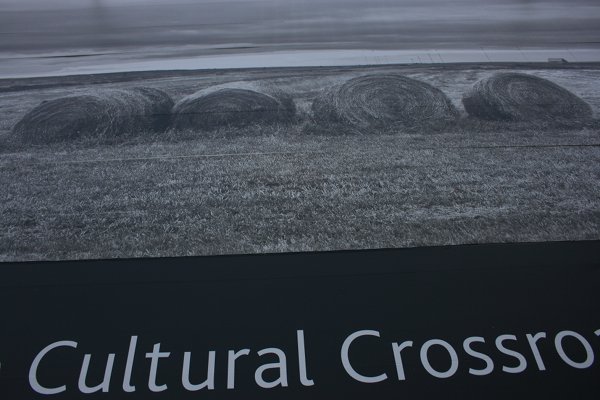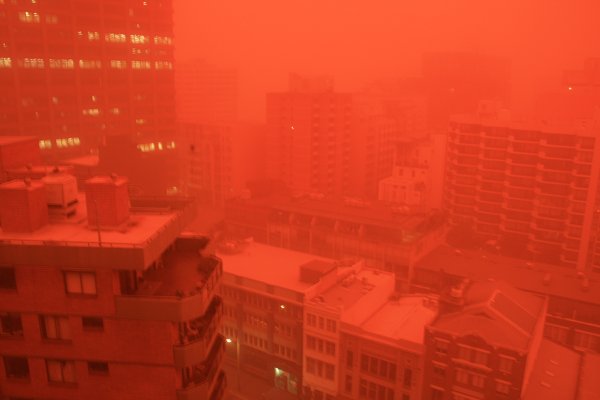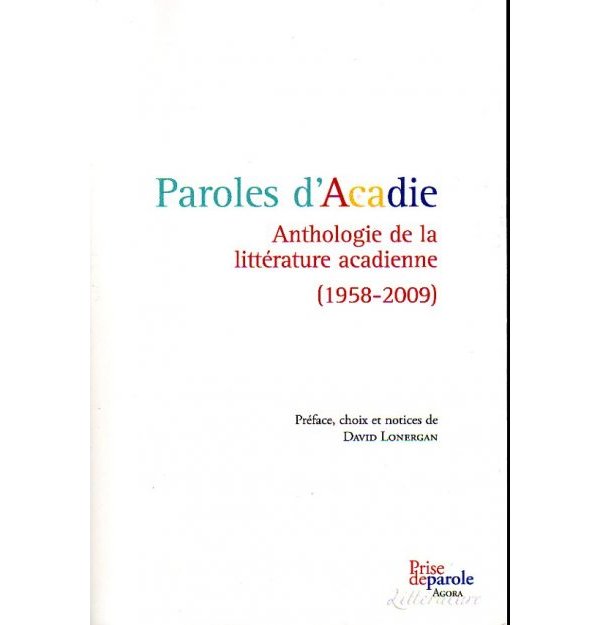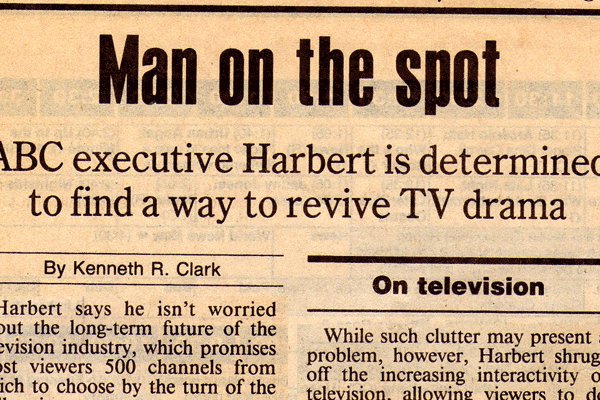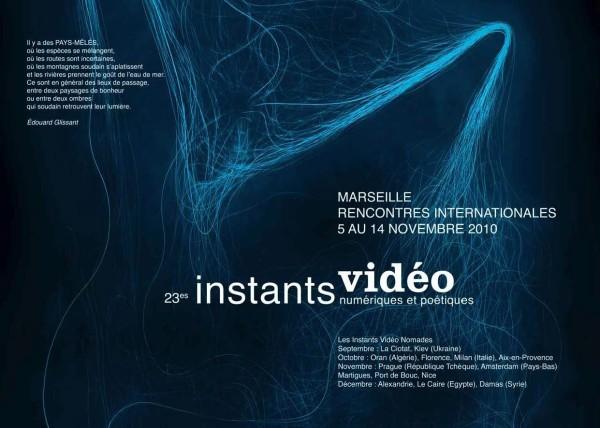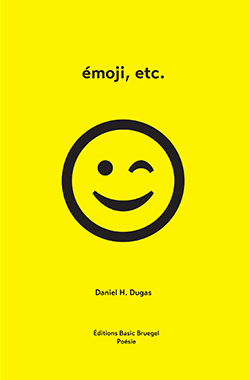The Swastika is gone!
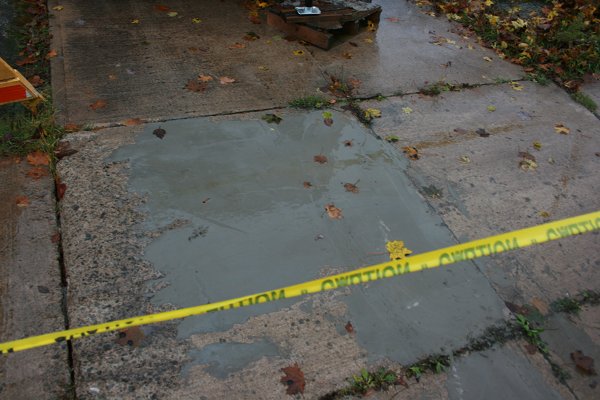
The City of Moncton came and repaired the sidewalk on Sherrard Street and it’s beautiful!
For background information, please see: A Swastika in Moncton
Sackville vs Pleasantville vs Ibiza (2010)
Style & Artifacts is a series of articles about the cultural symbolism of artifacts and monuments in landscapes and cityscapes. Black and white welcome signs, an outdoor sculpture that gets wrapped in winter, as well as bizarre swastikas patterns integrated into architecture are some of the topics that will be examined. The articles will be posted in episodes.
Editing assistance: Valerie LeBlanc
Sackville vs Pleasantville vs Ibiza
Sackville wanted to set itself apart from other towns by using black and white in their advertisements.[13] Well-done Sackville! I have to agree that the new signs contrast with others. One example being the colorful sign on Highway 15 near Moncton, that depicts two amazingly happy kids at a water park.
To present Sackville as a black and white destination may unintentionally have alluded to the movie Pleasantville. [14] You have to agree that Sackville and Pleasantville have a similar ring to them. This allegorical movie presents two universes; one in black and white, where old fashion values reign, and a modern one in full color. The protagonists go back and forth between the worlds and eventually the quaint little town changes its ways to become colorful. Are the utopias of Sackville and Pleasantville related? Should we, the tourists and the lonely truck drivers on the highway, be called in by the billboards? Should we emulate Bud and Mary Sue Parker in the Pleasantville movie by going into the black and white town, “to educate (the town) about issues such as personal freedoms, styles of art, and literature? ”[15]
Katie Tower of the Sackville Tribune wrote a critical article about the billboards: Does Town’s new highway sign say Sackville? [16] In it, she pointed out that the billboards were not ‘really saying much about the vibrant cultural scene that makes up this quaint university town known as Sackville”.[17] Tower is right about the vibrancy of the cultural scene but I don’t think the billboards are off target either. This town has not been misrepresented because this town is a quaint little place. Let face it Sackville is not Ibiza, the number one party town in the world.[18] It is true that Sackville has an impressive scope of activity for its size. In 2008, it was even named a Cultural Capital of Canada, [19] succeeding the town of Wendake, Quebec. But Sackville is above all quaint, meaning that it has an old-fashioned charm, that it is unusual in an interesting and pleasing way. The fact that it was selected by the Canadian Association of Retired Persons as one of the best places to live in Canada, [20] speaks volume about its pace. It is traditional and quiet, it is pastoral and the sign says it well.
But then if you look at the photograph a bit longer you can see all those little antennas, hidden by the speed of travel. Could this be a metaphor for the hidden wildness that can be found there? People say that every little town has its secrets. If it is true then maybe this is the real subtlety of the new identity campaign. It managed to evoke the most secret trait of its population without them realizing it. Perhaps beneath the tranquil exterior of idyllic, almost arcadian life, there is a wild heart beating. Maybe like a mullet, Sackville is all ‘business in the front and party in the back.’ That thought would be subject matter for further research.
Daniel Dugas,
Moncton, August – October 2010
[13] “Everything is in colour these days. Everybody wants to use colour and use the same thing to attract people to their community…but we don’t want to look like the other towns.” Graham Watt, member of Sackville Tourism Advisory Committee.Visitors will be welcomed to Sackville with unique image. Tower, K. (2009, May 6). Sackville Tribune Post.
[14] IMBd The Internet Movie Database
[15] Pleasantville (film). (2010, July 21). In Wikipedia, the free encyclopedia. Retrieved August 9, 2010, from http://en.wikipedia.org/wiki/Pleasantville_(film)
[16] Does towns new highway sign say Sackville?. Tower, K. (2009, June 17). Sackville Tribune Post.
[17] idem
[18] Best Party Cities in the World, Retrieved October 15, 2010, from: http://www.virgin-vacations.com/11-top-party-cities.aspx
[19] 2008 Cultural Capitals of Canada, Retrieved September 1st, 2010, from http://www.pch.gc.ca/pgm/ccc/ccc08-eng.cfm
[20] Sackville Arts Walk brochure – Feb. 2010
Nice town, y’know what I mean? (2010)
Style & Artifacts is a series of articles about the cultural symbolism of artifacts and monuments in landscapes and cityscapes. Black and white welcome signs, an outdoor sculpture that gets wrapped in winter, as well as bizarre swastikas patterns integrated into architecture are some of the topics that will be examined. The articles will be posted in episodes.
Editing assistance: Valerie LeBlanc
PART 1
Nice town, y’know what I mean?
Last year the town of Sackville, in an attempt to bring more people to town[1], installed two black and white billboards on the Trans-Canada highway. The team of marketing specialists believed that the use of a black and white image would create enough of a shock to achieve this goal. This æsthetic action created waves within the community. There were a few newspaper articles and letters to the editor written; some praising the audacity of the signs, and some others were more critical. After a year, I was curious to see how the marketing dust was settling in the ever-windy Tantramar Marsh.
Traveling in a northwesterly direction toward Sackville, I stopped on the side of the road in front of one of the billboards. I had seen the image[2] before, on a previous voyage, but this time I wanted to confront the bucolic scene at a different speed. I got out of the car to stand directly in front of the landscape image. It was huge. The four hay bales lying in a field was even bigger than I thought. The composition of the photograph was centered and balanced. The muted tones and the realism depicted spoke of time-honored tradition and conservatism. The blowup of the image had something of The Gleaners, an oil painting by Millet (1857), but without the peasants.
Looking at the photograph, I was reminded of the famous line by the Stage Manager, the narrator of the play Our Town[3] written by Thornton Wilder in 1937: Nice town, y’know what I mean? There was something warm and safe about it, even if was wrapped in the coldness of the black and white. Under the picture is a slogan stating that Sackville is the Cultural Crossroads of the Maritimes.
Marsh and Mirror
Trucks were traveling down the highway at ferocious speeds raising trails of dust behind them. I was taking pictures of the picture when I realized something both interesting and puzzling at the same time. The billboard image is a mirror of its surroundings. This, by itself, is interesting, after all mirrors are important tools of discovery. Montaigne spoke of the world “as a mirror where we must see ourselves in order to know ourselves,” [4] and Rabelais in a more sarcastic manner reminded us that “If you wish to avoid seeing a fool you must first break the mirror.” [5]
Like a Droste Effect,[6] the image of a marsh within a marsh, could make us question the reasons behind – or beyond the panels. Is the smaller black and white version of the marsh saying something important about the real thing? Is it augmenting or diminishing the existing reality? It is puzzling because there are unfortunately, no answers to inform or transform an understanding of the choice of the image. On that particular day, it looked like a visual hiccup planted on the landscape.
The signage was part of a new strategy to set Sackville apart from other communities. The Tourism Committee hoped that the distinctiveness of the image, ‘its art like qualities’ [7] would be so attractive that it would incite visitors to drive into town. But were there more tourists coming in? In answer to my inquiries, Rebekah Cant – Sackville’s Director of Tourism, offered to set up a meeting with two members from the Tourism Advisory Committee; Councilor Virgil Hammock[8] as well as idea manGraham Watt, who once worked as an advertising man on Madison Avenue. According to them, the billboards have been successful. People have been talking, some positively and yes, others negatively about the signs. If we believe that ‘There’s no such thing as bad publicity…’ [9] like Brendan Behan said, then this daring black and white coup might just work out!
Crossroads and Tollbooths
Marketing strategies are plans of actions and the slogan Sackville, the Cultural Crossroads of the Maritimes is part of the new identity promoted by the highway signs. But what is this Cultural Crossroad business? What does it mean? Like some people in Sackville that I spoke to, I thought it was a printing error. Was it supposed to read Agricultural Crossroads? After all, hay bales strongly point to cultivation.
A crossroad is a point of intersection. It is also the point where an important choice has to be made. Am I going straight or am I turning off? If the Trans-Canada Highway and the streets of Sackville are the cultural roads, then what important choice has to be made here? To stop? Maybe, although it might not be extremely important if you don’t need the usual services required by travelers. Does this great intersection of roads warrant our attention? Is there a traffic light where we will have to stop, or a tollbooth where we will have to toss a coin?
How can Sackville set itself apart from others when a crossroad is exactly about the importance and the dependency of others? Because, let’s not forget that without these ‘others’ there will be no crossroad at all.
Yore and “Ohm sweet Ohm”[10]
But let’s go back to the image: the sky is heavy with clouds, it rained earlier or it will at some point. It feels cold. It is nostalgia wrapped into melancholy. But why hay bales? Why this picture? I know that hay is feed for animals, that there are different qualities of feed and that one hay bale of this variety weights about 1,000 pounds. I know that making hay involves many steps; cutting; drying; processing and storing. But really what does it have to say about the town? Do Sackvillians live in straw houses? Is there a museum of Hay Fever? Can I buy a hay-bale-key-chain or a hay-bale-pen at the gas station?
But wait a minute, just above the bales, the sky is lighting up, or as Thornton Wilder wrote at the very beginning of his play ‘… Sky is beginnin’ to show some streaks of lights over the East there…’ [11] Yes! Now I see, parsed in the glimmer, a series of little sticks planted in the ground. These sticks are the antennas of the famous Radio Canada International transmitter station.[12] RCI has been located in the Tantramar Marshes since the early 40’s and it broadcasts a multilingual schedule of shortwave programs throughout the world. Could these high frequencies emitted from this colony of towers represent the cultural roads of Sackville? I don’t know but I could almost hear something…
The antennas in the background could actually be the clue that unlocks this marketing campaign mystery, but they are so small and so delicately drawn onto the landscape that they might not be seen at all. I doubt that the restless kid, in the backseat of the average minivan traveling at highway speeds, will notice them and start yelling to his parents: “MOM! DAD! ANTENNAS! ANTENNAS! CAN WE STOP AT THE RADIO CANADA INTERNATIONAL STATION PLEASE! PLEASE! PLEASE! CAN WE?”
End of part 1.
Tomorrow – the conclusion: Sackville vs Pleasantville vs Ibiza
[1] Tower, K. (2010, May 6). Visitors will be welcomed to Sackville with unique image. “In an effort to set itself apart from other communities, Sackville is taking a unique approach to drawing in visitors off the highway” Sackville Tribune Post.
[2] The photograph is part of the Radio Canada International portfolio created by renowned photographer Thaddeus Holownia during a 28-year period (1977-2006).
[3] Our Town. (2010, July 26). In Wikipedia, the free encyclopedia. Retrieved August 9, 2010, from http://en.wikipedia.org/wiki/Our_Town
[4] Michel De Montaigne quotes. Think exist – Finding Quotations was never this Easy!. Retrieved September 4, 2010 from http://thinkexist.com/quotation/traveling-through-the-world-produces-a-marvelous/347128.html
[5] François Rabelais quotes. Brainy Quote Retrieved September 4, 2010 from http://www.brainyquote.com/quotes/quotes/f/francoisra176266.html
[6] Droste effect. (2010, August 2). In Wikipedia, the free encyclopedia. Retrieved August 9, 2010, from http://en.wikipedia.org/wiki/Droste_effect
[7] Tower, K. (2010, May 6). Visitors will be welcomed to Sackville with unique image. Sackville Tribune Post.
[9] Strangely enough, we really acknowledge the latter part of the phrase: There’s no such thing as bad publicity except your own obituary. The Phrase Finder. Retrieved September, 1st, 2010, from http://www.phrases.org.uk/meanings/there-is-no-such-thing-as-bad-publicity.html
[10] “Ohm sweet Ohm” is a song on Radio-Activity a 1975 concept album around simulated radiowave and shortwave sounds by Kraftwerk. Radio-Activity. (2010, July 24). In Wikipedia, the free encyclopedia. Retrieved August 9, 2010, from http://en.wikipedia.org/wiki/Radioactivity_(album)
[11]“The first act shows a day in our town. The date is May 7, 1901, just before dawn. (COCK CROW off stage.) Aya, just about. Sky is beginnin’ to show some streaks of lights over the East there…..” Our town: a play in three acts By Thornton Wilder, from Google Books. Act 1, page 2.
[12] Radio Canada International. (2010, May 10)). In Wikipedia, the free encyclopedia. Retrieved August 9, 2010, from http://en.wikipedia.org/wiki/Radio_Canada_International
GO TO PART 2 : Sackville vs Pleasantville vs Ibiza
Poésie – 0 – 23es Instants Vidéo (2010)
Rouge sera présenté le 20 novembre 2010 à la Maison des Jeunes et de la Culture de Martigues en France, dans le cadre des 23es Instants Vidéo. Le programme intitulé Poésie – 0, débute à 15h30.
Maison des Jeunes et de la Culture
Boulevard Emile Zola
13500 Martigues, France
04 42 07 05 36
Abattue sur la ville rouge, une réflexion sur le gaz a tracé un portrait de genre sur le territoire infantile juste sous nos pieds.
Rouge de Daniel Dugas (Canada, 2010) 2’50
Centipede sun de Mihai Grecu (Roumanie, 2010) 10’
Mois de Brigitte Perroto (France/Allemagne, 2007) 5’30
Autoportraits minute 1/4 de José Man Lius (France,2009) 2’
Daidrim de Claude Yvroud (France, 2010) 11’03
L’amnésie infantile de India Solovieva (France, 2009) 15’
MARTIGUES MAISON DES JEUNES ET DE LA CULTURE
Bd Emile Zola 04 42 07 05 36
Salon du livre de la Péninsule Acadienne (2010)
Je reviens de Shipaggan où je participais à la 7ième édition du salon du livre de la Péninsule. Une très belle expérience avec un public nombreux. David Lonergan animait la Scène média avec une grande générosité et une énergie débordante! Il lançait sa nouvelle anthologie de la littérature acadienne intitulée Paroles d’Acadie (Éditions Prise de Parole) dans laquelle je figure : p 263-269
De plus il dirigeait la soirée littéraire Paroles d’Acadie où il a invité sur scène les auteurs et poètes Christian Brun, Herménégilde Chiasson, Gracia Couturier, Daniel Dugas, Melvin Gallant, Hélène Harbec, Georgette LeBlanc, Claude LeBouthillier, Marguerite Maillet et Serge Patrice Thibodeau.
Camille, Andrew, Katrina & Co, an essay By Tomas Jonsson (2010)
NECESSARY FICTIONS
Tomas Jonsson
There is a quote by Steve Rienke, the source for which I couldn’t find when I wrote this, that goes something like this: “Critical reviews often rely on an autobiographical experience to instill a personal connection to the work in question, a strategy operating with a mistaken assumption that this imbues the review with meaningful insight.” Implied in his criticism of subjective criticism is that it mistakes the object under interrogation. The suggestion is that critical writing should be more about the art object than about a personal experience of a work of art. Irecognize that I am often guilty of this, and after reading Rienke, I have made an effort -not always successfully- to adopt other strategies.
It is true that inserting oneself within the fabric of a critical response can be too easy a strategy, and often runs the risk of being less interesting than the work under discussion. Sometimes, however, the act of viewing is a subject of the work, and, when one viewer sees multiple works he or she is at the hub of a complex web of associations and judgments. Such is the case in my viewing of Nelson Henrick’s Failure, (2007, 7:00 minutes) and Daniel Dugas’ Camille, Andrew, Katrina and Co. (2008, 109 minutes). These two videos were screened at two distinct occasions as part of EMMEDIA’s CRASH! Narrative Explorations series. Beyond their obvious relation to the larger programming theme, something in the works sparked my curiosity, a sense that these works could speak to each other, that their respective strategies and explorations could offer some shared insight; a simultaneous push and pull at the borders of the conventions, and their personal identities that they worked with, and within. Both also implicate the viewer in the act of viewing, and challenge -subtly and overtly- passive reception of what we are witnessing.
Subtitled “self portrait 61,” Nelson Henrick’s Failure suggests an exhaustive interrogation of the artist. If the previous 60 video portraits (and perhaps more that follow) exist, this is the only one so far to surface for public presentation. It begins with Henricks lying on the floor while a melancholic piano from a Nina Simone song plays. In several shot cuts we then see him peeking out from over a kitchen counter and table, and then lying on the bed. The screen goes black before we hear him sigh and say ‘I think that is ok.” A conscious slip of editing that begins to trouble our acceptance of what we are receiving. In the second segment of this video, we see Henricks shaving, first his beard and then his legs, while the following subtitles play out:
Insert subtitles in this section
Text refers to events in adolescence
That inspired the action onscreen
But not in an obvious way
Keep it open-ended and ambiguous
Make the titles go on long enough
To preserve the integrity of the long take
Keep the performative gesture unedited
While also distracting the spectator
From their boredom
Or find another strategy
Like go to a cut-away
The subtitles reflect the actions on screen. We are left to imagine our own interpretation of the adolescent acts hinted at in this ritual (or why, for that matter, Henricks shaves his legs with his pants still around his ankles).
Following the scripted cut away of scene two (a long holding shot of the humming razor) the view shifts to a record player, and the needle positioned to a fragment of a Serge Gainsborough song, where a woman’s voice lustfully and repeatedly whispers ‘nelson’, the needle is lifted immediately following her third and last utterance of the –his- name. In the next scene, Henricks emerges awkwardly from behind a curtain in a photo studio and performs an equally awkward shuffle to a tune by Pavement. “Special Guest star” Benoit Chasse appears with a handwritten sign that reads “impoverished aesthetics”. A few very rapid cuts follow, in tune to the skipping of the audio track. Despite what this audio tic immediately suggests, none of this is accidental, but rather carefully constructed. These cuts offer a fleeting glimpse of Henricks engaged in the production of this work (setting up lights, etc.), before we return to see him again lying melancholic on the floor as the Nina Simone song plays out, extending into the credits.
Failure is coated with a thick ironic sheen. It reads like a challenge, offering a seductive possibility of inference while at the same time mocking any attempt at reading insight to Henricks’ exploration of identity, and any presumed failures, try as we might. How and where do we attribute failure? Is the performative ritual of shaving symbolic of the inferred adolescent events; a failure to align with gender conventions? We can’t confirm the readings as true regarding the subject outside of the video, but that does not prevent us from wanting – wishing – to know something of him through this construction.
Daniel Dugas’ Camille Andrew, Katrina and Co. exists in several formats, including a website, publication and script. The DVD version is presented in eight chapters and features optional English subtitles that mirrors the French voice that both informs us what we are seeing and provides all the character voices. At times, the visual narrative does not align with the verbal / textual description, and the results are jarring. It is as if the camera cannot keep up with the direction, or instead pursues its own aesthetic concerns. The imagery has a dream-like quality which plays out at a slow, relaxed pace, even during scenes of violent conflict or struggle.
The story follows the conventions of a crime scene drama— immediately familiar to anyone with a steady diet of televised crime shows like CSI—with some magic realism thrown in for good measure. The video employs continuous foreshadowing of the events to come, and cliffhanger endings to the episodic chapters. At times, it seems that the narrator has ambitions that cannot be realized by the constraints of the hand-held video and foley sound. There is a subtle irony to this voice-over; we don’t quite believe it. It takes us in and out of the story, reminding us that we are watching a construction. Perhaps this is a screen test for a later, more realized version.
There are a few stylistic flourishes, such as when we are drawn in to regard a painting of a ship in a storm. The camera moves into focus on one figure who, the narrator informs us, notices us, and who then begins to move up, floating or flying into the oncoming storm. The painting is in the house of Ted, who we come to recognize as the protagonist. He is cooking eggs in the kitchen of his 1970s bungalow (we are told). Over time, we come to learn more about him: his job at an insurance company; the convention he is to give a speech at; as well as larger, sinister forces that he will soon contend with as the (fore)shadow of an upcoming hurricane approaches.
We are only presented the characters in fragments. Dugas does double and triple service performing many of the characters, distinguishable only by their clothing or through representation of their actions. A conversation between Ted and his wife Suzie, for example, is only represented by their respective cups of coffee.
At the end credits, footage taken from houses destroyed from the real hurricane Katrina play out, and we are reminded this is not merely content fodder for a dramatic thriller. In the real world there were no industrious children (Ted’s son, Teddy and his friends) that saved New Orleans, and it is safe to assume that a convention of hurricanes did not plot out the damage to descend on this city. Thinking back on this piece, what can we take from this story and bring towards an understanding of the real events?
Both videos are self-conscious about the conventions of video; neither hide the construction of their form and content. Any engagement we might feel is continually subverted by our awareness of the external frames. These videos are performances. It means something that we recognize the role the artists play in this construction. In my search for the elusive quote by Steve Reinke, I did find this one, which makes this point plain:
“Through video, figures that were previously just functions of the text can be physically embodied in ways that radically undermine the stability of authors in relation to their texts and narrators. Video artists can be positioned both interiorly and exteriorly (behind and in front of the camera) to their texts in a way that is impossible for writers, who must always, despite all their desperate efforts to the contrary, remain off-page.”1
Reading this, I was reminded of watching Adaptation, a movie that, like these two videos, exposes filmic and narrative convention even as it follows it. In the climatic finale -an absurd battle between the protagonist, played by Nicholas Cage and a crocodile- induced hysterical laughter from myself and my friend, to the annoyance of others in the theatre who were more willing to go along with the story.2
As Reinke notes, video is more amenable to this kind of slippage. It can create a space where the real and the fiction can co-exist in a tense ambivalence that destabilizes the comfort of suspended belief. While these two works subvert the conventions of conventional filmic narrative, this subversion does not counteract but rather gives new life to tired, often meaningless, conventions. Through this tension we shift from passive viewers to active participants in the construction.
Of course, this terrain is well covered. I’m conscious that a comparative analysis of two works could be made of any number of tapes, and is in itself perhaps a banal strategy. With this risk in mind, these works, exposed to me over time and space, nevertheless instill in me a nagging thought that results in an impulse to translate this to print.
________________________________________________________________
1. Nelson Henricks’ Failure was screening on November 25th, 2010 along with Deborah Stratman’s O’er the Land. Daniel Dugas’ Camille Andrew, Katrina and Co. was screened on May 14, 2010
2. I would like to thank Donna Wawzonek for reminding me of this incident.
Download the full version of IMPACT STATEMENTS
© 2010 EMMEDIA Gallery & Production Society
All Rights Reserved
All rights reserved. No part of this publication
may be reproduced or transmitted in any form
without prior written permission from the publisher.
Library and Archiving Canada
Cataloguing in Publication
IMPACT STATEMENTS:
CRASH! Anthology of Critical Texts
ISBN 978-0-9737962-9-2
Published by
emPRESS
EMMEDIA Gallery & Production Society
#203, 351 – 11 Ave SW
Calgary, AB
Canada T2R 0C7
1-403-263-2833
www.emmedia.ca
Edited by David Garneau
Project managed by Tomas Jonsson
Design by Vicki Chau
Printed in Canada by Emerson Clarke Printing
Les Ciné-Débats à Moncton pendant le FICFA
J’ai été invité par le Front des réalisateurs indépendants du Canada (FRIC) à participer, à titre de panéliste, à une table ronde sur la réalisation et le web. Cette activité aura lieu au 6e étage de l’Hôtel de ville de Moncton au 655, rue Main. L’entrée est libre.
LES CINÉ-DÉBATS
Pilotés par le Front des réalisateurs indépendants du Canada, les Ciné-débats sont des occasions d’échanges entre réalisateurs / réalisatrices de la francophonie canadienne et le public. Par l’entremise de tables rondes, les Ciné-débats proposent d’étendre l’expérience des cinéphiles et festivaliers au Festival international du cinéma francophone en Acadie en créant un espace de discussions autour de la réalisation indépendante et de ses enjeux actuels.
La réalisation et le web présenté le vendredi 1er octobre 2010 à 13h avec Anne Worrall (Vancouver), Daniel Dugas (Moncton) et Benoît Beaudoin (Montréal) Depuis la popularisation d’Internet dans les années 1990, les artistes médiatiques et les réalisateurs abordent le Web comme moyen de diffusion pour leur travail, mais aussi comme outil de création. La ruée récente vers le multiplateforme comme approche à la création d’œuvres audiovisuelles donne une large responsabilité à Internet et aux outils qui y sont reliés. La création en 2009 du Fonds des médias du Canada vient confirmer cette tendance auprès de l’industrie en venant appuyer et même obliger la création d’œuvres pouvant être diffusées sous plusieurs formes (documentaire unique, épisodes, site Internet, jeu vidéo, logiciels pour téléphone, baladodiffusions, webisodes, mobisodes) et ce, sur de nombreuses plateformes (télévision, Internet, téléphone portable). Le Ciné-débat explore de multiples approches à la création cinématographique avec Internet. Les intervenants partageront leur expérience de créer en utilisant Internet, tout en abordant l’influence que peut avoir ce médium dans le développement d’œuvres et les nouveaux rouages dorénavant partie prenante de la production audiovisuelle.
La revue Liaison vient de publier une critique de Hé! (2010)
Extrait:
« Tout le charme du recueil tient dans l’élaboration de cette réflexion existentielle sur un ton ludique, décapant, foisonnant de liberté, en se servant d’un cadre discursif contraignant mais libérateur. En fait, l’énergie du discours est peut-être la meilleure expression de la liberté existentielle évoquée, faisant de ce recueil un joyeux géant qui rit. »
Gille Lacombe
Liaison no 149, Automne 2010 p.57
Les Instants Vidéo – numériques et poétique (2010)
Ma vidéo Rouge sera présentée lors des 23es Instants Vidéo. La manifestation se déroulera cette année du 3 septembre au 20 décembre 2010 (exposition d’installations vidéo, projections internationales d’art vidéo et documentaires de création, performances, rencontres…) en France (Marseille, Martigues, Port-de-Bouc, Aix, Nice, La Ciotat), Syrie, Egypte, République Tchèque, Algérie, Pays-Bas.
Daniel H. Dugas
Archives
Blogroll
- A.I.R. Vallauris
- ACAD
- Adobe additional services
- Adobe Creative Cloud
- AIRIE
- Amaas
- Amazon Author Central
- ARTothèque
- Australian Poetry
- Basic Bruegel
- Bitly
- CCCA
- CDBaby
- Cycling 74
- Dissolution
- Éditions Prise de parole
- Emmedia
- eyelevelgallery
- FAVA
- Festival acadien de poésie
- Festival FRYE Festival
- FILE – Electronic Language International Festival
- Freeware list
- Fringe Online
- Galerie Sans Nom
- Gotta Minute Film Festival
- Instants Vidéo
- JUiCYHEADS
- Kindle Direct Publishing
- Klondike Institute of Art and Culture
- La Maison de la poésie de Montréal
- La Maison de la Poésie et de la Langue française Wallonie-Bruxelles
- Laboratorio Arte-Alameda
- Le Centre Jacques Cartier
- Liberated Words
- Maison Internationale de la Poésie – Arthur Haulot
- MediaPackBoard
- Miami Book Fair International
- Monoskop
- Mot Dit
- NSCAD University
- Paved Arts
- PoetryFilm
- Portail des auteurs du Nouveau-Brunswick
- RECF
- Revue Ancrages
- Salon du Livre du Grand Sudbury
- Sculpture Space
- Subtropics.org
- Sydney college for the arts
- The Centre for Contemporary Canadian Art
- The New Gallery
- Trevigliopoesia
- tumbler-documents
- V Tape
- Valerie LeBlanc
- VideoBardo
- Void Network-Κενο Δίκτυο
Categories
- #covidpoèmes
- Advertisement
- AIRIE
- Ancrages
- anthology
- Anthropocene
- Architecture
- Around Osprey
- art
- Article de presse
- arts visuels
- audio
- Australian Poetry
- Basic Bruegel Editions
- Book
- book fair
- Cafe Poet Program
- Ce qu'on emporte avec nous
- Citations gratuites
- Collaboration
- commentaire
- commentary
- Compte rendu
- conférence
- Conservation Foundation of the Gulf Coast
- COVID-19
- Critique littéraire
- culture
- Daniel Dugas
- Design
- Édition Michel-Henri
- Éditions Perce-Neige
- Éloizes
- Emmedia
- emoji etc | émoji etc
- Environnement
- essai
- essay
- Everglades
- Exhibition
- festival
- Festival acadien de poésie
- Festival Frye Festival
- FIPTR
- Flow: Big Waters
- Fundy
- Habitat
- installation
- Instants Vidéo
- interactivity
- journal
- JUiCYHEADS
- Kisii
- L'Esprit du temps
- laptop
- Leaving São Paulo
- lecture
- Livre
- logos
- Magazine
- Miami Book Fair
- Moncton 24
- novel
- OASIS
- oil spill
- perception
- performance
- Photo
- poésie
- Poetic Licence Week
- Poetry
- politics
- politique
- press
- Prise de parole
- Revue Ancrages
- salon du livre
- sculpture
- Sculpture Space
- sound
- Souvenirs
- Spirit of the Time
- Style & Artifacts
- Symposium d'art/nature
- talk
- television
- The New Gallery
- Uncategorized
- Valerie LeBlanc
- vidéo
- vidéopoésie
- Videopoetr/Vidéopoésie
- videopoetry
- visual arts
- What We Take With Us
- youth literature






